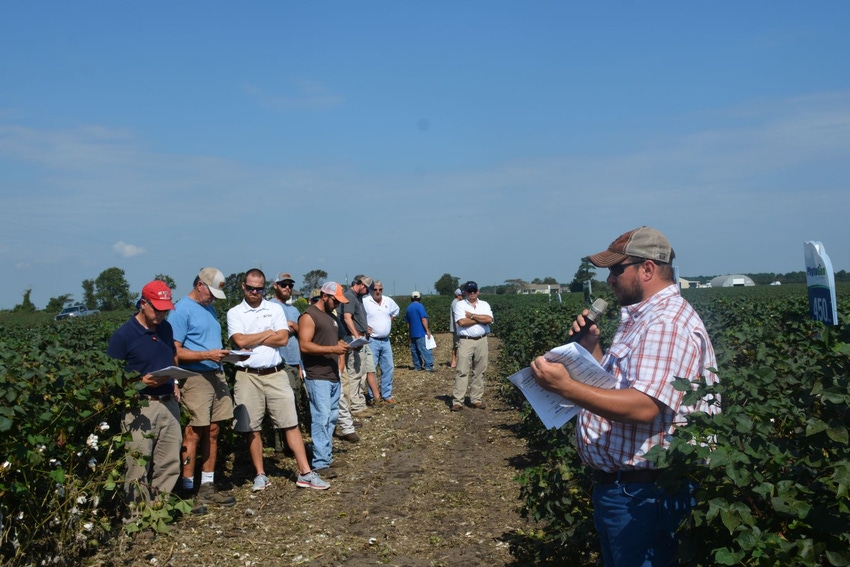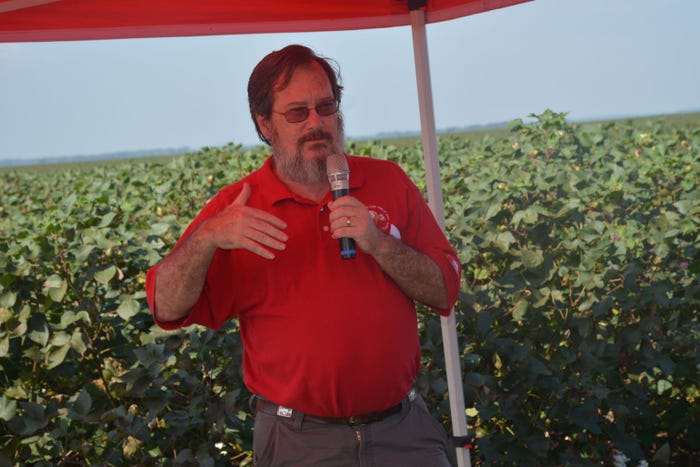
Cotton varieties with the most vegetative growth potential require intensive plant growth regulator or PGR management in irrigated or well-watered conditions while varieties with the least growth potential may seldom need PGR applications, especially prior to bloom.
For varieties slightly more responsive to PGRs or earlier in maturity, pre-bloom applications are often unnecessary in dryland conditions especially when dry conditions occur. However, Blackland growers are least likely to experience excessively dry conditions compared to other parts of North Carolina.
These are important guidelines to remember, but North Carolina State University Cotton Extension Associate Professor Guy Collins notes there are exceptions to these rules. Farmers need to manage their plant growth manage PGRs on a field-by-field, case-by-case basis.
“PGR requirements vary depending on environment. Use this only as a very general guide to categorize variety growth potential,” Collins said at the Blackland Cotton Field Day at Southland Farms in Belhaven, N.C. Sept. 21.
Collins is conducting research in North Carolina gauging the response of various cotton varieties to an aggressive PGR management strategy. “We are trying to determine which varieties are most likely to shut down and respond to PGRs. The varieties with more horsepower and more aggressive growth characteristics may need multiple PGR applications,” Collins said.
Varieties with the most aggressive growth potential are less likely to respond to PGRs and multiple applications are needed, probably starting prior to bloom, followed by a first bloom and possibly a mid-bloom application.
Collins notes that the medium maturing varieties that are slightly more responsive to PGRs than full-season varieties and are often the most challenging to manage because they tend to behave differently in different growing environments. They require at least on application and possible multiple applications, starting at squaring to first bloom, depending on soil moisture and field history.
“Varieties with the least growth potential are most likely to respond to PGRs and they are fairly easy manage. There are a lot of cases across the state and in different soil types, where they don’t need a PGR strategy whatsoever,” Collins said. “If they do need PGRs, most of the time you can start at first bloom and manage them fairly well.”
In the meantime Keith Edmisten, Extension cotton specialist at N.C. State, explains that it is a misconception that the plant growth regulator Pix makes cotton go into fruiting mode. He said he hears this often and it is not true.
“There’s no such magic as that,” Edmisten said. “Cotton generally starts fruiting at about the fifth to seventh node, depending on what variety it is and what the temperature was when it was at about the one to two leaf stage. Those all have an impact on when it starts fruiting.”
Once a cotton plant starts fruiting, it will continue to fruit, with a very few exceptions. “It may not keep its fruit. Dry weather and insect damage may cause you to lose fruit, but cotton never goes back into a vegetative mode,” Edmisten said. “If you lose fruit, it may appear it is vegetative, but if you look at that growth, it is all reproductive growth. There is nothing you can spray on your cotton to make it shift from a vegetative to fruiting mode.”
Edmisten stresses that it is important to remember that Pix impacts future growth, not past growth. He explains that Pix can affect boll retention because it makes cells smaller. It does not shrink full grown leaves; it only affects leaves that have not fully expanded.
“Pix is going to affect cell expansion and that’s going to make the leaves smaller. It’s going to make the internode smaller. If you get more sunlight in the lower canopy, you keep more of those lower bolls. That’s what makes the cotton earlier. It’s a matter of lower fruit retention purely due to more sunlight in the lower canopy. Pix doesn’t shrink cotton. It affects the future growth,” Edmisten said. ]

Keith Edmisten, North Carolina State University Extension cotton specialist, says it is a misconception that the plant growth regulator Pix makes cotton go into fruiting mode.
About the Author(s)
You May Also Like






